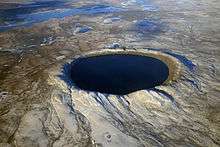Shock metamorphism
Shock metamorphism or impact metamorphism describes the effects of shock-wave related deformation and heating during impact events.
The formation of similar features during explosive volcanism is generally discounted due to the lack of metamorphic effects unequivocally associated with explosions and the difficulty in reaching sufficient pressures during such an event.[1]
Effects
Mineral microstructures
Planar fractures
Planar fractures are parallel sets of multiple planar cracks or cleavages in quartz grains; they develop at the lowest pressures characteristic of shock waves (~5–8 GPa) and a common feature of quartz grains found associated with impact structures. Although the occurrence of planar fractures is relatively common in other deformed rocks, the development of intense, widespread, and closely spaced planar fractures is considered diagnostic of shock metamorphism.[2]
Planar deformation features

Planar deformation features, or PDFs, are optically recognizable microscopic features in grains of silicate minerals (usually quartz or feldspar), consisting of very narrow planes of glassy material arranged in parallel sets that have distinct orientations with respect to the grain's crystal structure. PDFs are only produced by extreme shock compressions on the scale of meteor impacts. They are not found in volcanic environments.
Brazil twinning in quartz
This form of twinning in quartz is relatively common but the occurrence of close-spaced Brazil twins parallel to the basal plane, (0001), has only been reported from impact structures. Experimental formation of basal-orientated Brazil twins in quartz requires high stresses (about 8 GPa) and high strain rates, and it seems probable that such features in natural quartz can also be regarded as unique impact indicators.[2]
High-pressure polymorphs
The very high pressures associated with impacts can lead to the formation of high-pressure polymorphs of various minerals. Quartz may occur as either of its two high-pressure forms, coesite and stishovite. Coesite occasionally occurs associated with eclogites formed during very high pressure regional metamorphism but was first discovered in a meteorite crater in 1960.[3] Stishovite, however, is only known from impact structures.
Two of the high-pressure polymorphs of titanium dioxide, one with a baddeleyite-like form and the other with a α-PbO2 structure, have been found associated with the Nördlinger Ries impact structure.[4][5]
Diamond, the high-pressure allotrope of carbon, has been found associated with many impact structures, and both fullerenes and carbynes have been reported.[6]
Shatter cones
Shatter cones have a distinctively conical shape that radiates from the top of the cones repeating cone-on-cone, at various scales in the same sample. They are only known to form in rocks beneath meteorite impact craters or underground nuclear explosions. They are evidence that the rock has been subjected to a shock with pressures in the range of 2-30 GPa.[7][8][9]
Rajlich's Hypothesis
There exist macroscopic white lamellae inside quartz and other minerals in the Bohemian Massif and at other places around the world like wavefronts generated by a meteorite impact according to the Rajlich's Hypothesis.[10][11][12] The hypothetical wavefronts are composed of many microcavities. Their origin is seen in a physical phenomenon of ultrasonic cavitation, which is well known from the technical practice.
Occurrence
The effects described above have been found singly, or more often in combination, associated with every impact structure that has been identified on Earth. The search for such effects therefore forms the basis for identifying possible candidate impact structures, particularly to distinguish them from volcanic features.
See also
References
- A. J. Gratz, A.J., W. J. Nellis, W.J. & Hinsey, N. 1992. Laboratory Simulations of Explosive Volcanism and Implications for the K/T boundary. Abstracts of the Lunar and Planetary Science Conference, volume 23, page 441.
- Chapter 4, 'Shock-Metamorphic Effects in Rocks and Minerals' of the online book, French, B.M. 1998. Traces of Catastrophe, A handbook of shock-metamorphic effects in terrestrial meteorite impact structures, Lunar and Planetary Institute 120pp.
- Chao, E. C. T.; Shoemaker, E. M.; Madsen, B. M. (1960). "First Natural Occurrence of Coesite". Science. 132 (3421): 220–222. Bibcode:1960Sci...132..220C. doi:10.1126/science.132.3421.220. PMID 17748937.
- El Goresy, A; Chen, M; Dubrovinsky, L; Gillet, P; Graup, G (August 2001). "An ultradense polymorph of rutile with seven-coordinated titanium from the Ries crater". Science. 293: 1467–70. doi:10.1126/science.1062342. PMID 11520981.
- El Goresy, Ahmed (2001). "A natural shock-induced dense polymorph of rutile with α-PbO2 structure in the suevite from the Ries crater in Germany". Earth and Planetary Science Letters. 192: 485–495. Bibcode:2001E&PSL.192..485E. doi:10.1016/S0012-821X(01)00480-0.
- Gilmour, I (1999). "Carbon allotropes in impact-produced rocks". Meteoritics & Planetary Science. 34: A43. Bibcode:1999M&PSA..34R..43G.
- French, B.M. (1998). Traces of Catastrophe. Lunar and Planetary Institute. Retrieved 2007-05-20.
- Sagy, A.; Fineberg, J.; Reches, Z. (2004). "Shatter cones: Branched, rapid fractures formed by shock impact" (PDF). Journal of Geophysical Research. 109 (B10): B10209. Bibcode:2004JGRB..10910209S. doi:10.1029/2004JB003016. Archived from the original (PDF) on 2009-02-27.
- French, Bevan M. (2005). "Stalking the Wily Shatter Cone: A Critical Guide for Impact-Crater Hunters" (PDF). Impacts in the Field. Impact Field Studies Group. 2 (Winter): s 3–10. Archived from the original (PDF) on 2011-07-20.
- 1944-, Rajlich, Petr (2007-01-01). Český kráter. Jihočeské muzeum. ISBN 9788086260808. OCLC 276814811.CS1 maint: numeric names: authors list (link)
- 1944-., Rajlich, Petr (2014-01-01). Vesmírná příhoda v Českém křemeni (a v Českém masivu). Geologie. ISBN 9788026056782. OCLC 883371161.CS1 maint: numeric names: authors list (link)
- Mestan, J.; Alvarez Polanco, E. I. (2014-12-01). "Density Variations in Quartz As a Key for Deciphering Impact-Related Ultrasonic Sounding (Rajlich's Hypothesis)?". AGU Fall Meeting Abstracts. 11: MR11A–4310. Bibcode:2014AGUFMMR11A4310M.

